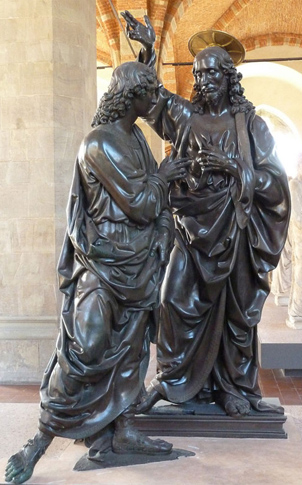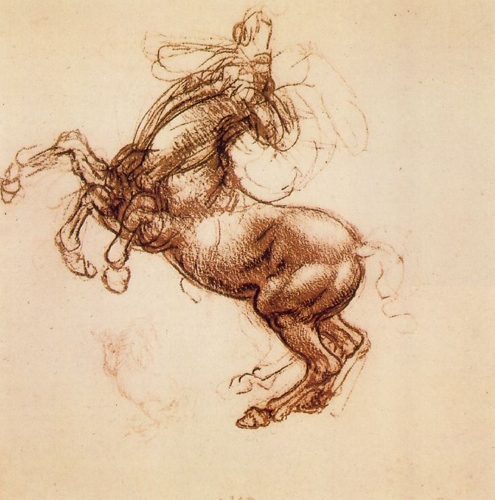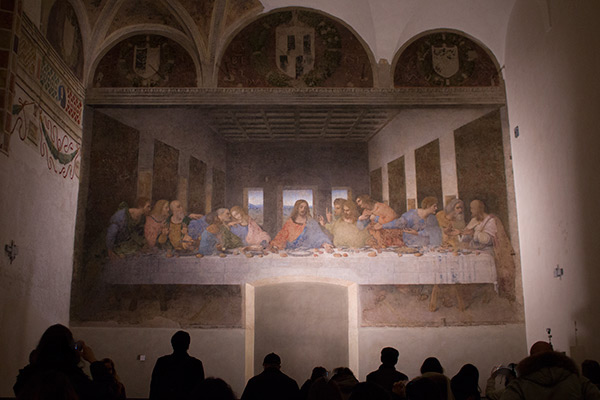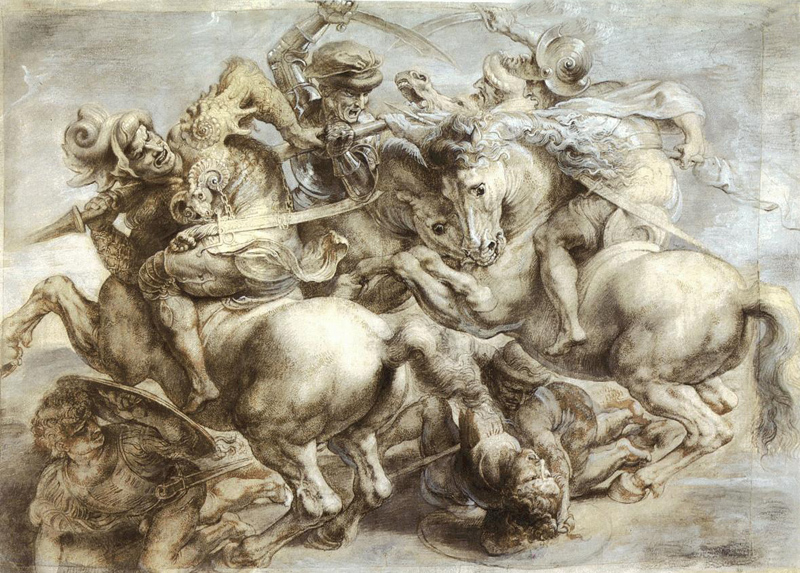|
In the minds of many, the name Leonardo Da Vinci is synonymous
with the Renaissance movement. What many find so amazing about
Leonardo was his proficiency in a great many subjects. It was
in the workshop of Andrea Del Verrocchio, most famous for his
sculpting ability, that Leonardo received his apprentice training
as an artist (Fleming 200). Verrocchio
was noted as being very scientific minded and it is likely that
this had a great influence on the young Leonardo. Here, he was
able to begin to develop his artistic talents while also being
exposed to many scientific questions. In the course of his life,
Leonardo created a huge volume of artistic and scientific works,
and as a result little is ever mentioned of his failures. His
most notable failure as an artist was his attempt at a mural
entitled The Battle of Anghiari.
Left, Andrea Del Verrocchio
Christ and Doubting Thomas
|
|
 |
 Rearing Horse by Leonardo
Rearing Horse by Leonardo, c. 1483-1498 - Red
chalk
|
In October of 1503 Leonardo received his most notable commission
from the city of Florence. He was commissioned by Piero Soderini,
Gonfaloniere of the Signoria of Florence, to decorate one of
the walls of the chamber created for the Great Council in the
Palazzo Vecchio. The painting was intended to be of a patriotic
nature, depicting the Florentine victory over the Milanese army
at the Battle of Anghiari in 1440. Shortly after Leonardo's
commission, Michelangelo was commissioned to paint a battle
scene on the opposite chamber wall. Michelangelo's subject was
an incident that occurred during the Battle of Cascina
(1364) in which several Florentine soldiers were surprised by
the Pisan enemy while bathing (Field 314).
Michelangelo's recent completion of David had established
him as the master of the male nude; therefore this scene was
suited to his abilities. The Battle of Anghiari was a
battle of mounted soldiers, and at the time Leonardo was considered
to be the master of depicting horses (see examples below). The
stage was set for the two greatest artists of the time to face
off. But this dual of the artists would never really materialize.
In 1504 Michelangelo was called off to Rome by Pope Julius II,
and would never return to finish his work in Florence.
|
By May of 1504, Leonardo's contract was revised due his employer's
concern with his lack of progress. This new contract required that he
first complete a cartoon of the battle scene (now lost) by February
(Orosz). Large rooms were required for
Leonardo to draw the full-scale cartoon. It is believed that the cartoon
was completed at or around March of 1505. Leonardo actually began painting
"on the sixth day of June, 1505, a Friday, on the stroke
of 13 hours… and when I raised my brush a storm broke out…[the sheets
of the cartoon fell apart], there was heavy rain until evening and it
was dark as night" (Field 316).
This may have been an omen of the misfortune that was to come.
The majority of the murals that were successfully done during the Renaissance
were created using a technique called fresco (Italian meaning "fresh").
There are two main types of fresco, 'dry' fresco (fresco secco)
and 'wet' fresco (fresco buono), with wet being the more commonly
utilized form (Field 202). In fresco buono
a fresh wet layer of plaster is applied to a prepared wall surface and
the pigments used in the actual painting are soaked in water to facilitate
their absorption into the plaster. A chemical bond forms between the
paint and the wall surface as the paint dries and the two are permanently
fused together. This technique allows the paints to last as long as
the plaster remains intact. One of the down sides to this method is
that the artist must know exactly what he is doing, because substantial
corrections can not be made as a result of the rapid drying of the pigments.
Fresco is also vulnerable to damage from exposure to high humidity.
The color range in Fresco is much more limited than that of oil paintings
with darker colors being especially difficult to implement. The difficulty
associated with implementing dark colors onto fresco murals is believed
to have heavily contributed to the brightness of Renaissance murals.
Leonardo's mentor, Verrocchio, never learned the fresco technique and
as a result was not able to teach it to Leonardo. Consequently, when
Leonardo painted his Last Supper mural (1495-97) he devised a
new mural technique more consistent with his style that incorporated
oil. This technique had advantages over the orthodox fresco technique
in that it allowed him to work at a slower pace and make alterations
as needed (Field 211). Unfortunately this
medium did not wear well and his masterpiece soon began to wear away.
In fact today, little of Leonardo's original work on the Last Supper
remains.

The Last Supper, Convent of Santa Maria delle Grazie,
Milan
By 1505 Leonardo was already aware of the fact that his Last Supper
was beginning to show signs of deterioration. Despite this observation
he continued to deviate from the more durable orthodox fresco technique
while working on the Battle of Anghiari. In this case he used
a method that involved mixing pigments with wax. This mixture, when
heated, bonded to the wall (Field 317).
It is believed that Leonardo derived this method from studies of the
ancient method of encaustic (translation: fixing by heat) he encountered
in a book by Pliny. Leonardo found it very difficult to dry the paint
using this technique. Scholars theorize that this was the result of
the types of oils he used and the fact that when flame was used to dry
it, the colors at the top would run. Scholars have pointed out that
Leonardo must have missed a crucially important part of Pliny's instructions
for the encaustic technique: "Those among the colors which require
a dry, cretaceous coating and refuse to adhere to a wet surface are
purpurissum, indicum, caeruleum, milinum, orpiment, appianum, ceruse.
Wax, too, is stained with all of these coloring substances, for encaustic
painting; a process which does not admit of being applied to walls…"
Leonardo's troubles became so severe that sometime around October of
1505 he stopped working on the painting altogether. Angered by this,
Piero Soderini, the man who initially commissioned Leonardo, complained
to the French that Leonardo was paid a substantial amount of money and
had done very little work. Leonardo did eventually return, but no further
work was reported as having been done. Remaining data has led modern
historians to conclude that, contrary to Soderini's claims, Leonardo
completed a great deal of painting.

Sketch by Leonardo, Battle of Anghiari
Today none of Leonardo's original work on the Battle of Anghiari
or the preliminary cartoon survives. Much of what scholars know about
this project has come from Leonardo's notes and sketches as well as
several copies of parts of the painting that were done before it was
completely painted over in 1570 by Giorgio Vasari. Leonardo kept detailed
notes about how he was going to paint each battle scene. An excerpt
reads, "Make the conquered and beaten pale, their brows raised and knit,
and the skin above their brows furrowed with pain…some of the victors
leaving the fight and issuing from the crowd, rubbing their eyes and
checks with both hands to clean them of the dirt made by their watering
eyes smarting from the dust and smoke" (Field 317).
The most notable copy that survives today is actually a re-work done
by Rubens of an authentic copy by an unknown 16th century
Italian master (Orosz). This captures
the central episode of the Battle of Anghiari called the Battle
of the Standard (just one scene in Leonardo's plan for the Battle
of Anghiari).

The Battle of Anghiari, by Peter Paul Rubens
Warrior Sketches for The Battle of Anghiari by Leonardo
|
Works Cited
Field, D.M. Leonardo Da Vinci. New Jersey: Wellfleet
Press, 2002.
Fleming, William. Arts and Ideas. New York: Holt, Rinehart, and
Winston, 1980.
"Battle of Anghiari" Loadstar's Lair. 12/02/2002: http://www.lairweb.org.nz/leonardo/battle.html
Cross, Lamm, and Rudy Turk. The Search for Personal Freedom.
Dubuque: Wm. C. Brown Company Publishers, 1981.
De La Croix, Tansey, and Diane Kirkpatrick. Art Through the Ages.
New York: Harcourt Brace College Publishers, 1991.
Orosz, Martin and Monika Kumin. "Leonardo Da Vinci: Studies for the
'Battle of Anghiari' in the Budapest Museum of Fine Arts." 23 Apr.
2001; Fondazione Romualdo Del Bianco
Back To Students
2002 | Back Home | Next
|